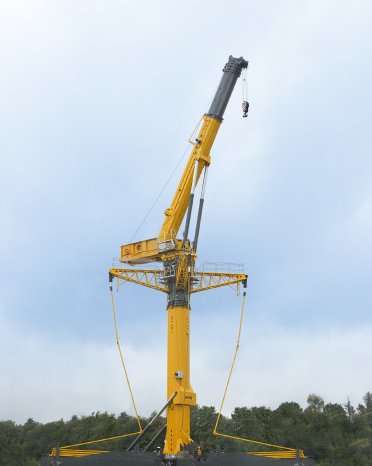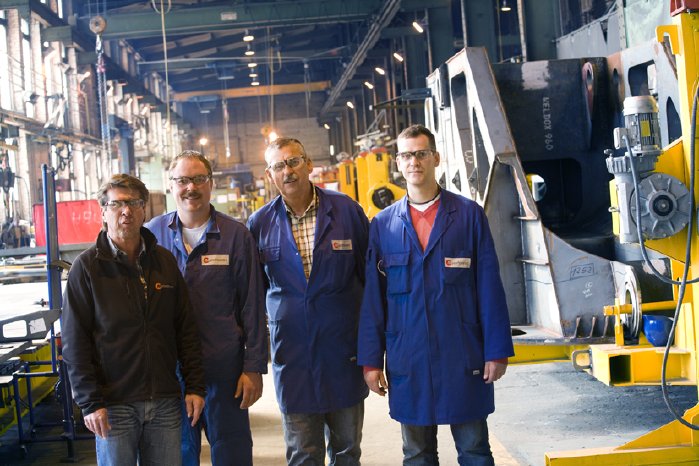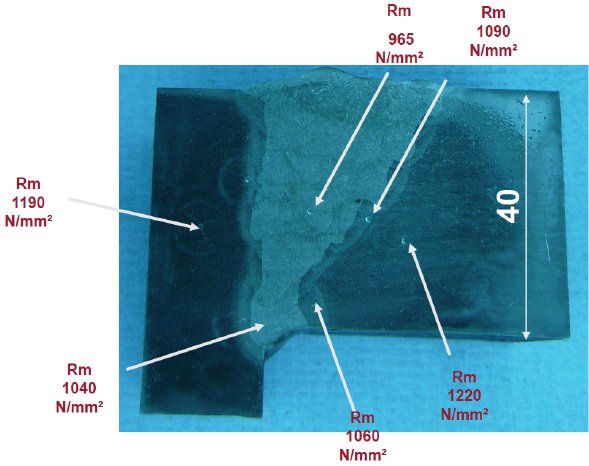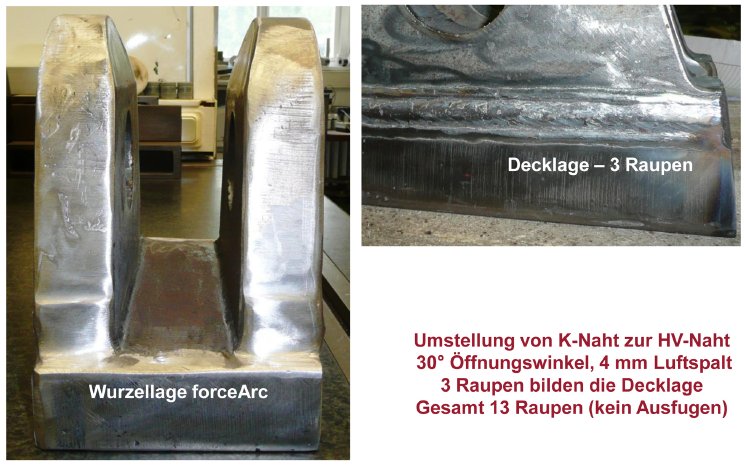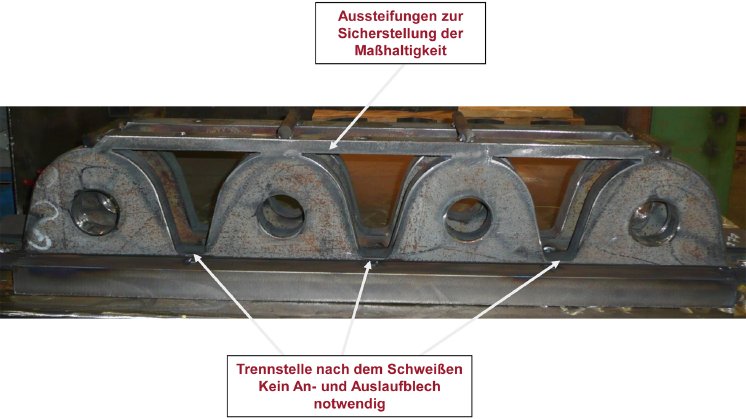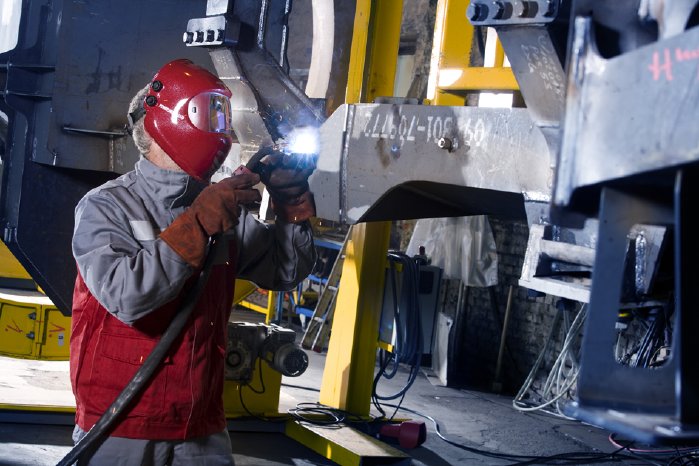The factory is more than just a production site: along with Design & Development, the factory is also home to prototype construction with a test area for the European crane types. The components of the huge cranes - whether booms, rotary tables, chassis frames or supporting beams - are made from high-strength, fine-grained steel of varying qualities (Fig. 2). Before welding, they pass through various processing stations: thermal cutting, bevelling, edging and mechanical processing. As in all areas the main factors for the company when choosing the welding process are quality and efficiency. This is why, along with the two submerged welding robots for longitudinal seams, 50 conventional metal active gas (MAG) power sources are in use.
Dipl.-Ing. Michael Hüneke is the company's production manager and in charge of the mechanical department. In addition, the welding engineer is the primary contact person for all European factories when it comes to thermal joining. A total of 70 welders, 2 master welders and 1 welding expert currently work alongside him (Fig. 3).
Fascinated and alarmed at the same time
It's already a fact that the world of joining will be changing considerably at Manitowoc. Michael Hüneke likes looking back to the start of the change: "A year ago, the EWW welding specialist Dieter Kocab paid us a visit. He showed us a lot of test pieces from his case of welding samples - all of which were welded with the internationally acclaimed MAG process forceArc®. Then we were able to experience what any expert would describe as completely impossible: he demonstrated how one could weld a full-depth weld with a defined fillet weld on the seam root - without any chamfering whatsoever." The welding engineer goes on to recount his amazement at the full-depth weld on the 10 mm steel sheet and the realisation that he was experiencing something here that had been considered impossible until now: "I was fascinated and alarmed at the same time. Fascinated by the possibilities that such a process, without any chamfering whatsoever, would open up to us and alarmed because it would trigger a revolution in steel construction."
It was clear to the expert that this process represented a contradiction to the principles that were regarded in the sector as irrefutable: High-strength, fine-grain structural steels must be welded with low energy per unit length in order to keep transformation of the join within acceptable tolerances - forceArc® works with high levels of energy per unit length. Hüneke adds: "However, practice shows us that, in this case, large-grain structure is not produced from the fine-grain structure in the heat-affected zone. All strength values in our hardness tests have proved this" (Fig. 4).
The magic words "Production costs halved"
The new joining process at Manitowoc is inseparable from the Phoenix 521 puls inverter power source. It creates such a powerful and precise arc thanks to the highly dynamic control. The Wilhelmshaven factory initially projected the possibility of forceArc® on one of their applications: A 40-millimetre thick metal sheet which, until now, was prepared for a double-bevel seam (45 degree preparation angle on the back, 60 degree on the front), was now given a 30-degree single bevel seam. With the old double-bevel butt weld method, the root was welded from the front, gouged from the rear and finally filled from both sides. Now it is merely welded from one side and filled - the root with forceArc®, the filler and final passes with the pulse arc by simply flicking a switch on the torch. Hüneke adds: "We got amazingly good root formation - entirely without pool backing. We had this phenomenon tested several times by material testing institutes; the results were all positive. I am convinced that this will be the future course of our joining technology." Ever cost-conscious, the manager goes on to say: "Needless to say that our products are subjected to strong competition. As I mentioned that we could save 50 percent of production costs with welding and preparatory work, our controllers and businessmen opened their arms to me."
Three days saved
The new way of joining has already replaced traditional MAG welding for several applications in Northern Germany. For example, a particularly heavy locking console for the GMK 7450 mobile crane was welded in this way (Fig. 5). Due to bad accessibility, air arc gouging and welding the backing run were extremely difficult on this component made of S 960 QL fine-grained steel. In addition, each part had to be provided with run-in and run-out plates for the beginning and end of the weld. The expert Hüneke puts it like this: "Keeping closely to our design, we constructed the component according to forceArc® principles and now produce in lots of four (Fig. 6). This means that we can do without the backing pass and save two gouging and filling operations in a place that is particularly hard to reach. We just weld through, save welding consumables (DR-SG 100 X/20) and, not least, shielding gas (M21 conforming to EN ISO 14175). We would have needed 32 welding beads including final pass for the old production method. With the new 30-degree method, we can do it with just 13 beads" (Fig. 7). The savings potential with forceArc® is even more transparent when expressed in production days. The production manager calculates the production time today with two shifts as opposed to five shifts in the past.
Process innovation slims down production
Hüneke is fully convinced of the future of "his" new machine/process combination: "It will simplify things significantly in production, even eliminating time-consuming steps. It means that our bevel grinding system and flame cutting machine will be used less frequently. This is because we previously needed two bevels for each side of the sheet for a double-bevel seam, and we now only need one for a single bevel seam. It also means that there is no need to handle the components between processing steps."
The new era of welding at the crane manufacturer Manitowoc can also be seen in terms of quality. The fact that fewer steps are required means that the quality to be produced is achieved at a much earlier stage. The heat input to the workpiece is also simpler to define in advance and shrinkage processes can be anticipated better which is especially helpful when designing. Traditional MAG welding requires several work steps with a high level of heat input as well as constantly new positioning: Welding of seam root and the first intermediate passes, gouging the back of the root, partly filling the backing pass, filling the first side and welding the final pass, filling the backing pass and welding the final pass - with the new technology steps two, three and five are no longer necessary (Fig. 8).
